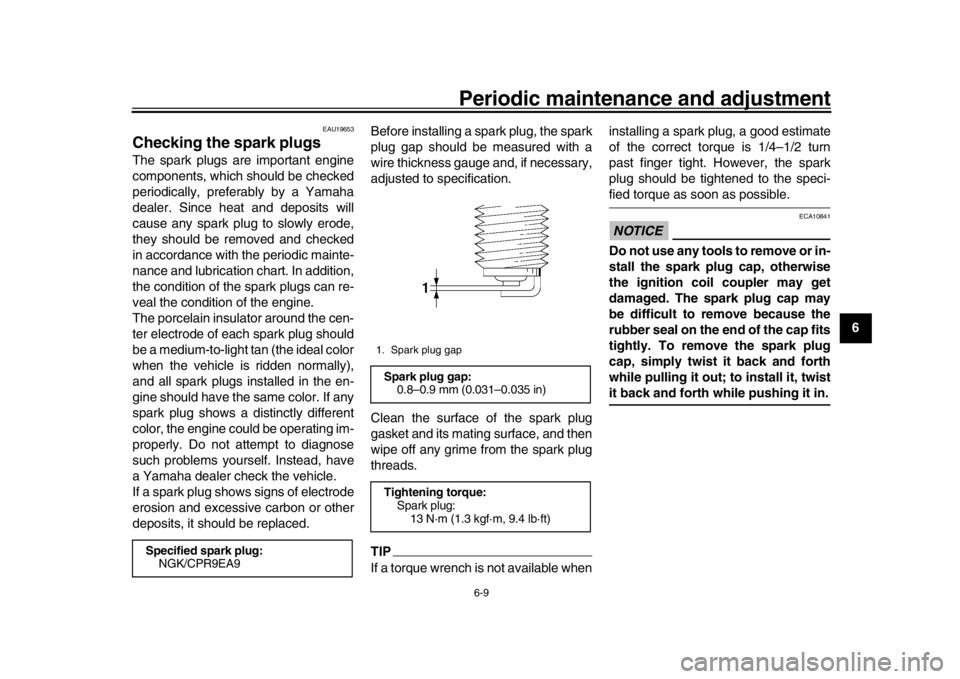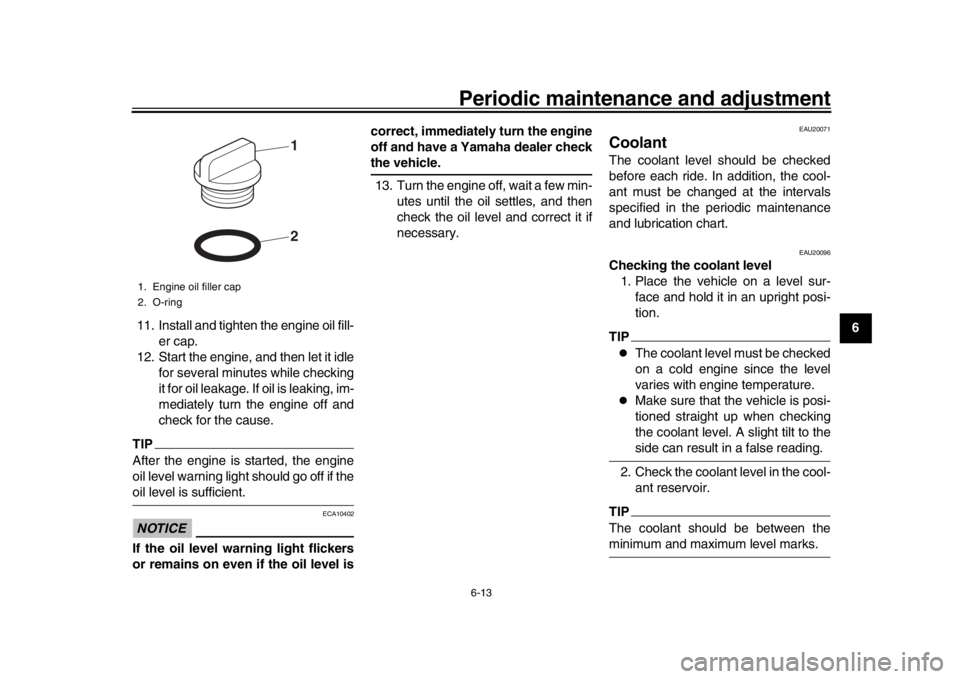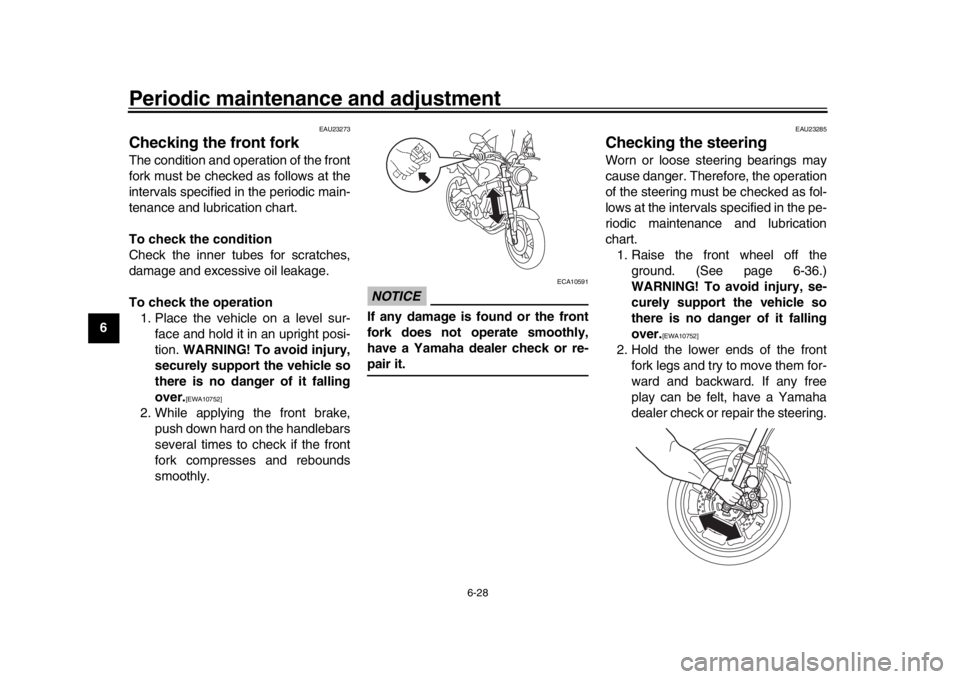checking oil YAMAHA XSR 900 2017 Owners Manual
[x] Cancel search | Manufacturer: YAMAHA, Model Year: 2017, Model line: XSR 900, Model: YAMAHA XSR 900 2017Pages: 104, PDF Size: 7.42 MB
Page 6 of 104

Table of contentsSafety information........................... 1-1
Description ....................................... 2-1
Left view ......................................... 2-1
Right view ....................................... 2-2
Controls and instruments................ 2-3
Instrument and co ntrol functions... 3-1
Immobilizer system ..... .................... 3-1
Main switch/steering lock................ 3-2
Indicator lights and warning
lights ............................................ 3-4
Multi-function meter unit ................. 3-6
D-mode (drive mode).................... 3-13
Handlebar switches ...................... 3-14
Clutch lever................................... 3-16
Shift pedal..... ............................ .... 3-16
Brake lever ................................... 3-16
Brake pedal .................................. 3-17
ABS .............................................. 3-17
Traction control syst em ................ 3-18
Fuel tank cap ................................ 3-20
Fuel............................................... 3-20
Fuel tank breather hose and overflow hose ............................ 3-22
Catalytic converter ........................ 3-22
Seat .............................................. 3-23
Storage compartment ................... 3-24
Adjusting the front fork.................. 3-24
Adjusting the shock absorber assembly ................................... 3-26 Luggage strap holders .
................ 3-27
Sidestand ..................................... 3-28
Ignition circuit cut- off system ........ 3-28
Auxiliary DC connector................. 3-30
For your safety – pre-operation
checks .............................................. 4-1
Operation and important riding
points ................................................ 5-1
Starting the engine ......................... 5-1
Shifting ........................................... 5-2
Tips for reducing fuel consumption ............................... 5-3
Engine break-in .............................. 5-3
Parking ........................................... 5-4
Periodic maintenance and
adjustment ....................................... 6-1
Owner’s tool kit............................... 6-2
Periodic maintenance chart for the emission control system ....... 6-3
General maintenance and
lubrication chart .......................... 6-5
Checking the spark plugs ............... 6-9
Canister ........................................ 6-10
Engine oil and oil filter cartridge ... 6-10
Coolant ......................................... 6-13
Air filter element ........................... 6-15
Checking the engine idling speed ........................................ 6-15 Checking the throttle grip free
play ........................................... 6-15
Valve clearance ........................... 6-16
Tires ............................................. 6-16
Cast wheels ................................. 6-18
Adjusting the clutch lever free play ........................................... 6-19
Checking the brake lever free
play ........................................... 6-19
Brake light switches ..................... 6-20
Checking the front and rear
brake pads................................ 6-20
Checking the brake fluid level ...... 6-21
Changing the brake fluid .............. 6-22
Drive chain slack.......................... 6-23
Cleaning and lubricating the drive chain ................................ 6-24
Checking and lubricating the cables ....................................... 6-25
Checking and lubricating the
throttle grip and cable ............... 6-25
Checking and lubricating the brake and shift pedals .............. 6-26
Checking and lubricating the brake and clutch levers ............ 6-26
Checking and lubricating the sidestand .................................. 6-27
Lubricating the swingarm
pivots ........................................ 6-27
Checking the front fork................. 6-28
Checking the steering .................. 6-28B90-9-E1.book 1 ページ 2017年2月15日 水曜日 午後1時59分
Page 61 of 104

Periodic maintenance and adjustment
6-9
1
2
3
4
567
8
9
10
11
12
EAU19653
Checking the spark plugsThe spark plugs are important engine
components, which should be checked
periodically, preferably by a Yamaha
dealer. Since heat and deposits will
cause any spark plug to slowly erode,
they should be removed and checked
in accordance with the periodic mainte-
nance and lubrication chart. In addition,
the condition of the spark plugs can re-
veal the condition of the engine.
The porcelain insulator around the cen-
ter electrode of each spark plug should
be a medium-to-light tan (the ideal color
when the vehicle is ridden normally),
and all spark plugs installed in the en-
gine should have the same color. If any
spark plug shows a distinctly different
color, the engine could be operating im-
properly. Do not attempt to diagnose
such problems yourself. Instead, have
a Yamaha dealer check the vehicle.
If a spark plug shows signs of electrode
erosion and excessive carbon or other
deposits, it should be replaced. Before installing a spark plug, the spark
plug gap should be measured with a
wire thickness gauge and, if necessary,
adjusted to specification.
Clean the surface of the spark plug
gasket and its mating surface, and then
wipe off any grime from the spark plug
threads.
TIPIf a torque wrench is not available wheninstalling a spark plug, a good estimate
of the correct torque is 1/4–1/2 turn
past finger tight. However, the spark
plug should be tightened to the speci-
fied torque as soon as possible.NOTICE
ECA10841
Do not use any tools to remove or in-
stall the spark plug cap, otherwise
the ignition coil coupler may get
damaged. The spark plug cap may
be difficult to remove because the
rubber seal on the end of the cap fits
tightly. To remove the spark plug
cap, simply twist it back and forth
while pulling it out; to install it, twistit back and forth while pushing it in.
Specified spark plug:
NGK/CPR9EA9
1. Spark plug gapSpark plug gap:0.8–0.9 mm (0.031–0.035 in)
Tightening torque: Spark plug:13 N·m (1.3 kgf·m, 9.4 lb·ft)
B90-9-E1.book 9 ページ 2017年2月15日 水曜日 午後1時59分
Page 65 of 104

Periodic maintenance and adjustment6-13
1
2
3
4
567
8
9
10
11
12
11. Install and tighten the engine oil fill-
er cap.
12. Start the engine, and then let it idle for several minutes while checking
it for oil leakage. If oil is leaking, im-
mediately turn the engine off and
check for the cause.
TIPAfter the engine is started, the engine
oil level warning light should go off if theoil level is sufficient.NOTICE
ECA10402
If the oil level warning light flickers
or remains on even if the oil level is correct, immediately turn the engine
off and have a Yamaha dealer check
the vehicle.
13. Turn the engine off, wait a few min- utes until the oil settles, and then
check the oil level and correct it if
necessary.
EAU20071
CoolantThe coolant level should be checked
before each ride. In addition, the cool-
ant must be changed at the intervals
specified in the periodic maintenance
and lubrication chart.
EAU20096
Checking the coolant level1. Place the vehicle on a level sur- face and hold it in an upright posi-
tion.TIP
The coolant level must be checked
on a cold engine since the level
varies with engine temperature.
Make sure that the vehicle is posi-
tioned straight up when checking
the coolant level. A slight tilt to theside can result in a false reading.
2. Check the coolant level in the cool- ant reservoir.
TIPThe coolant should be between theminimum and maximum level marks.
1. Engine oil filler cap
2. O-ring
21
B90-9-E1.book 13 ページ 2017年2月15日 水曜日 午後1時59分
Page 80 of 104

Periodic maintenance and adjustment
6-28
1
2
3
4
56
7
8
9
10
11
12
EAU23273
Checking the front forkThe condition and operation of the front
fork must be checked as follows at the
intervals specified in the periodic main-
tenance and lubrication chart.
To check the condition
Check the inner tubes for scratches,
damage and excessive oil leakage.
To check the operation 1. Place the vehicle on a level sur- face and hold it in an upright posi-
tion. WARNING! To avoid injury,
securely support the vehicle so
there is no danger of it falling
over.
[EWA10752]
2. While applying the front brake, push down hard on the handlebars
several times to check if the front
fork compresses and rebounds
smoothly.
NOTICE
ECA10591
If any damage is found or the front
fork does not operate smoothly,
have a Yamaha dealer check or re-pair it.
EAU23285
Checking the steeringWorn or loose steering bearings may
cause danger. Therefore, the operation
of the steering must be checked as fol-
lows at the intervals specified in the pe-
riodic maintenance and lubrication
chart.1. Raise the front wheel off the ground. (See page 6-36.)
WARNING! To avoid injury, se-
curely support the vehicle so
there is no danger of it falling
over.
[EWA10752]
2. Hold the lower ends of the frontfork legs and try to move them for-
ward and backward. If any free
play can be felt, have a Yamaha
dealer check or repair the steering.
B90-9-E1.book 28 ページ 2017年2月15日 水曜日 午後1時59分
Page 101 of 104

10-1
1
2
3
4
5
6
7
8
91011
12
Index
AABS ...................................................... 3-17
ABS warning light ................................... 3-5
Air filter element.................................... 6-15
Auxiliary DC connector ......................... 3-30
Auxiliary light bulb, replacing ................ 6-34BBattery .................................................. 6-29
Brake and clutch levers, checking and lubricating .................................... 6-26
Brake and shift pedals, checking and lubricating .................................... 6-26
Brake fluid, changing ............................ 6-22
Brake fluid level, checking .................... 6-21
Brake lever ........................................... 3-16
Brake lever free play, checking ............ 6-19
Brake light switches .............................. 6-20
Brake pedal .......................................... 3-17
Brake/tail light ....................................... 6-35CCables, checking and lubricating .......... 6-25
Canister ................................................ 6-10
Care ........................................................ 7-1
Catalytic converter ................................ 3-22
Clutch lever........................................... 3-16
Clutch lever free play, adjusting ........... 6-19
Coolant ................................................. 6-13
Coolant temperature warning light.......... 3-4DData recording, vehicle ........................... 9-2
Diagnostic connecto r .............................. 9-2
Dimmer switch ...................................... 3-14
D-mode (drive mode)............................ 3-13
Drive chain, cleaning and lubricating .... 6-24Drive chain slack ................................... 6-23
EEngine break-in ....................................... 5-3
Engine idling speed,
checking............... 6-15
Engine oil and oil filter cartridge ............ 6-10
Engine serial number ..............................9-1
Engine trouble warning light .................... 3-5FFront and rear brake pads, checking .... 6-20
Front fork, adjusting .............................. 3-24
Front fork, checking............................... 6-28
Fuel ....................................................... 3-20
Fuel consumption, tips for reducing ........5-3
Fuel tank breather hose and
overflow hose ...................................... 3-22
Fuel tank cap......................................... 3-20
Fuses, replacing .................................... 6-30HHandlebar switches ............................... 3-14
Hazard switch........................................ 3-15
Headlight bulb, replacing....................... 6-33
High beam indicator light .........................3-4
Horn switch ........................................... 3-15IIdentification numbers .............................9-1
Ignition circuit cut-off system ................. 3-28
Immobilizer system ................................. 3-1
Immobilizer system indicator light ........... 3-5
Indicator lights and warning lights ........... 3-4LLicense plate light ................................. 6-36
Luggage strap holders .......................... 3-27MMain switch/steering lock ........................3-2 Maintenance and lubrication, periodic .... 6-5
Maintenance, emission control system ... 6-3
Matte color, caution ................................ 7-1
Model label ............................................. 9-2
Multi-function meter unit ......................... 3-6
NNeutral indicator light .............................. 3-4OOil level warning light .............................. 3-4PParking.................................................... 5-4
Part locations .......................................... 2-1
Pass switch ........................................... 3-14SSafety information ................................... 1-1
Seat ...................................................... 3-23
Shifting .................................................... 5-2
Shift pedal ............................................. 3-16
Shock absorber assembly, adjusting .... 3-26
Sidestand .............................................. 3-28
Sidestand, checking and lubricating ..... 6-27
Spark plugs, checking ............................. 6-9
Specifications.......................................... 8-1
Starting the engine.................................. 5-1
Steering, checking ................................ 6-28
Stop/Run/Start switch ........................... 3-15
Storage ................................................... 7-3
Storage compartment ........................... 3-24
Supporting the motorcycle .................... 6-36
Swingarm pivots, lubricating ................. 6-27TThrottle grip and cable, checking
and lubricating .................................... 6-25
Throttle grip free play, checking............ 6-15
B90-9-E1.book 1 ページ 2017年2月15日 水曜日 午後1時59分